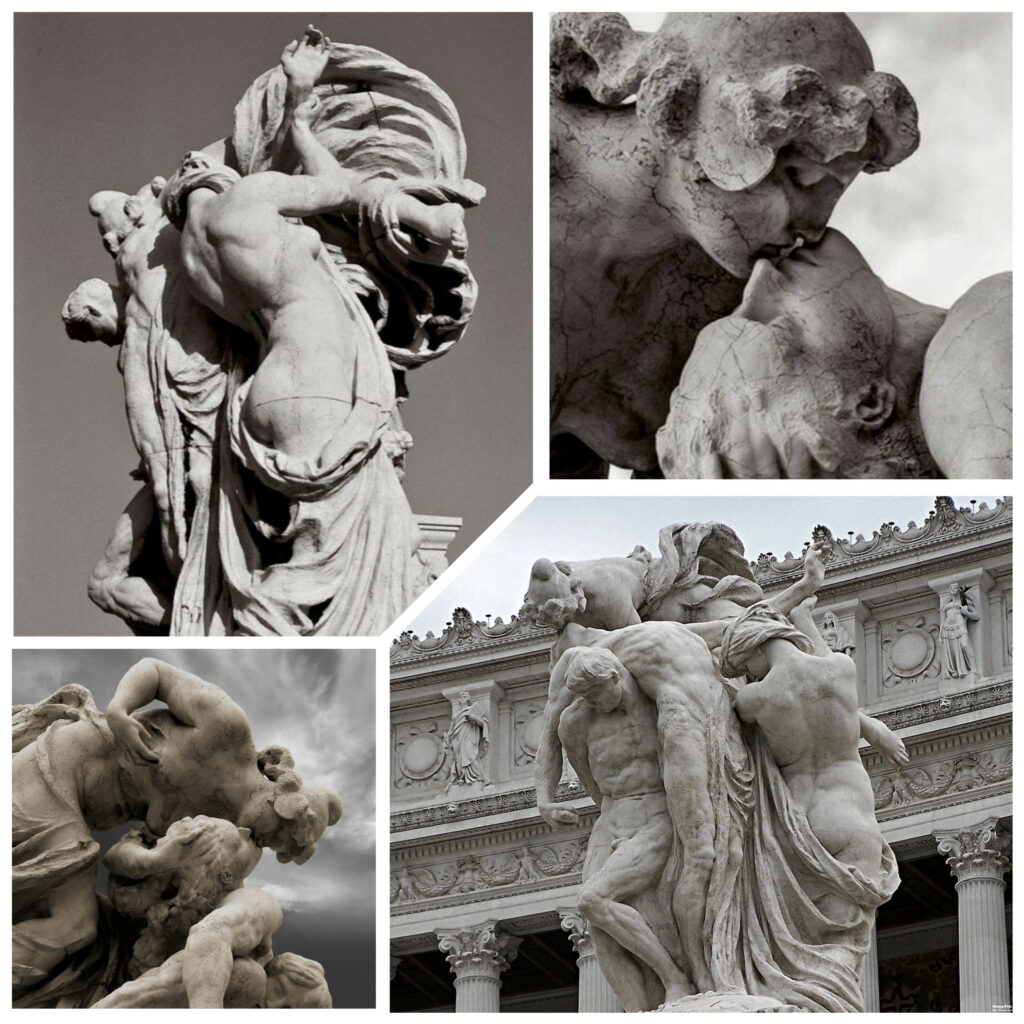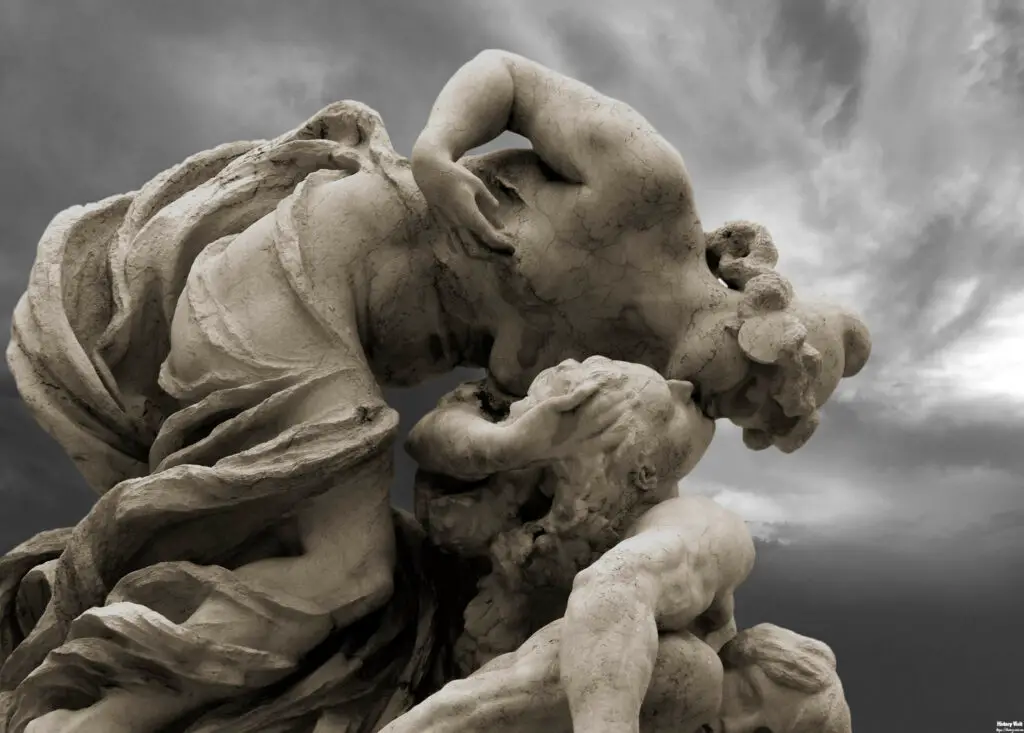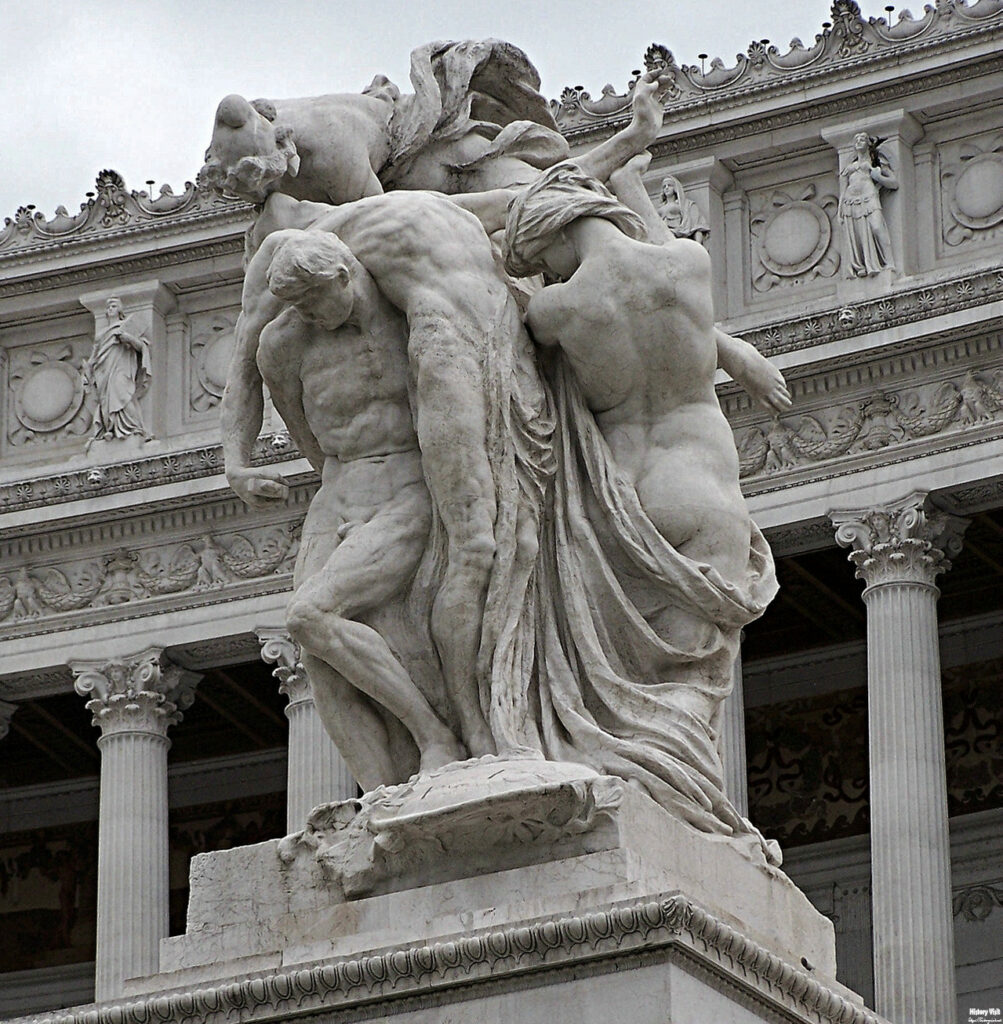Sacrifice by Leonardo Bistolfi (1911): An Artistic Testament to Human Devotion

Introduction
Leonardo Bistolfi, a distinguished Italian sculptor of the late 19th and early 20th centuries, left an indelible mark on the world of art through his profound explorations of human emotion and spirituality. Among his many celebrated works, the sculpture “Sacrifice” (1911) stands out as a poignant testament to the themes of selflessness and devotion. Created during a time of significant social and political upheaval, “Sacrifice” not only reflects the existential concerns of its era but also transcends its historical context to offer a timeless meditation on the nature of human sacrifice.
In “Sacrifice,” Bistolfi masterfully combines the Symbolist emphasis on emotional depth with the fluid, organic forms characteristic of the Art Nouveau movement. The sculpture’s depiction of a serene figure in a state of peaceful resignation captures the essence of voluntary self-sacrifice, inviting viewers to contemplate the profound implications of such an act. This article delves into the context, symbolism, artistic significance, and enduring legacy of Bistolfi’s “Sacrifice,” highlighting how this remarkable piece continues to resonate with audiences more than a century after its creation.
Context and Background

Leonardo Bistolfi was born in Casale Monferrato, Italy, in 1859, and throughout his career, he became a prominent figure in Italian sculpture. His early education at the Accademia Albertina in Turin laid a solid foundation for his artistic endeavors. Bistolfi was profoundly influenced by the Symbolist movement, which sought to convey complex emotional and spiritual ideas through art. This influence is evident in much of his work, including “Sacrifice,” created in 1911. By this time, Bistolfi was already recognized for his ability to imbue marble with a sense of life and emotion, making him one of the leading sculptors of his era.
The early 20th century was a period of significant change and turmoil in Europe. Political shifts, social upheaval, and the approach of World War I created an atmosphere of uncertainty and reflection. Artists like Bistolfi responded to these changes by exploring deeper human themes in their work. “Sacrifice” emerges from this context, reflecting a society grappling with the concepts of duty, selflessness, and mortality. The sculpture captures the zeitgeist of its time, offering a contemplative response to the broader cultural and existential questions of the era.

Bistolfi’s engagement with Symbolism was not merely stylistic but deeply philosophical. Symbolist artists aimed to go beyond the literal representation of subjects, seeking to express the invisible and the ineffable. This approach required a nuanced understanding of form and symbolism, skills that Bistolfi honed over his career. “Sacrifice” is a prime example of how Bistolfi used these techniques to evoke a sense of spiritual and emotional depth, making the sculpture a profound statement on the nature of human existence.
Additionally, Bistolfi was active during the rise of the Art Nouveau movement, which emphasized organic forms and intricate details. His ability to blend the Symbolist focus on emotional depth with the Art Nouveau penchant for fluid, natural lines made his work particularly compelling. “Sacrifice” thus represents a confluence of artistic movements, showcasing Bistolfi’s ability to synthesize different styles and themes into a cohesive and moving work of art.
The Sculpture: An Overview

“Sacrifice” by Leonardo Bistolfi is a striking example of his ability to transform marble into a medium that conveys deep emotional resonance. The sculpture depicts a figure in a pose of serene resignation, possibly representing a young man or woman. The subject’s calm and composed demeanor suggests an acceptance of their fate, embodying the theme of self-sacrifice. Bistolfi’s attention to detail is evident in the delicate rendering of the figure’s features, which capture a sense of inner peace and strength.
The use of marble in “Sacrifice” is particularly noteworthy. Bistolfi was adept at manipulating this hard, unforgiving material to create a sense of softness and fluidity. The gentle curves and subtle textures of the sculpture give it a lifelike quality, making the figure appear almost as if it could breathe. This technical mastery is one of Bistolfi’s trademarks, and it allows the viewer to connect with the sculpture on a deeply emotional level.

The composition of “Sacrifice” is both simple and profound. The figure is depicted in a solitary pose, emphasizing the personal nature of the sacrifice being made. This focus on the individual highlights the universality of the theme, suggesting that the act of self-sacrifice is a common thread in the human experience. The minimalist approach also directs the viewer’s attention to the emotional and spiritual aspects of the work, rather than to extraneous details.
Bistolfi’s ability to convey complex emotions through simple forms is one of the reasons why “Sacrifice” remains a powerful piece of art. The sculpture speaks to the viewer on multiple levels, inviting contemplation and reflection. It is a testament to Bistolfi’s skill as an artist and his deep understanding of the human condition. Through “Sacrifice,” Bistolfi not only showcases his technical abilities but also his profound capacity to express the intangible aspects of life.
Symbolism and Interpretation

At its heart, “Sacrifice” is a meditation on the concept of giving oneself for a greater good. The figure’s serene expression and composed posture suggest a voluntary act of selflessness, one that is undertaken with a full understanding of its significance. This portrayal of sacrifice emphasizes the nobility and purity inherent in such acts, aligning with the broader Symbolist theme of exploring the higher aspects of the human spirit. Bistolfi’s sculpture invites viewers to consider the motivations and implications of self-sacrifice in their own lives.
The symbolism in “Sacrifice” is rich and multi-layered. The figure’s calm demeanor implies a spiritual transcendence, suggesting that through the act of sacrifice, one can achieve a higher state of being. This idea resonates with the Symbolist movement’s fascination with the mystical and the metaphysical. The sculpture can be interpreted as an allegory for the soul’s journey towards enlightenment, where personal sacrifice is seen as a necessary step in the pursuit of spiritual growth.
Additionally, “Sacrifice” can be viewed as a commentary on the broader social and cultural context of its time. The early 20th century was a period of significant upheaval, with many individuals called upon to make personal sacrifices for the greater good of their communities and nations. Bistolfi’s work captures this collective experience, reflecting the shared sense of duty and responsibility that characterized the era. The sculpture serves as both a tribute to those who made such sacrifices and a reminder of the enduring value of selflessness.
The universal themes explored in “Sacrifice” ensure its relevance across different times and cultures. While the sculpture is rooted in the specific historical context of early 20th-century Europe, its exploration of selflessness and devotion speaks to fundamental aspects of the human experience. By focusing on these timeless themes, Bistolfi created a work that transcends its immediate context, offering insights that remain pertinent to contemporary audiences.
Artistic Significance

“Sacrifice” is not just a remarkable piece of art; it is also a significant cultural artifact. It reflects the artistic and philosophical currents of its time, while also transcending its historical context to speak to universal human experiences. Bistolfi’s work bridges the gap between the tangible and the intangible, using the physical medium of marble to explore deeply spiritual and existential themes.
One of the key elements of Bistolfi’s artistic significance lies in his ability to merge different styles and movements. “Sacrifice” exemplifies this synthesis, combining the emotional depth and symbolic richness of Symbolism with the fluid lines and organic forms of Art Nouveau. This fusion creates a unique aesthetic that is both visually striking and emotionally evocative, showcasing Bistolfi’s versatility and innovation as an artist.
The technical mastery displayed in “Sacrifice” further enhances its artistic importance. Bistolfi’s skillful manipulation of marble to create a sense of softness and lifelike presence is a testament to his expertise as a sculptor. This technical prowess allows the emotional and symbolic content of the sculpture to shine through, making it a powerful and moving piece of art. The delicate details and nuanced textures of the figure demonstrate Bistolfi’s attention to detail and his ability to breathe life into stone.
“Sacrifice” also holds a significant place within the broader canon of early 20th-century art. It reflects the period’s preoccupation with themes of mortality, spirituality, and the human condition, while also showcasing the stylistic innovations of the time. Bistolfi’s work contributes to the ongoing dialogue between different artistic movements, highlighting the interconnectedness of Symbolism, Art Nouveau, and other contemporary trends. By examining “Sacrifice,” one can gain a deeper understanding of the artistic and cultural landscape of the early 20th century.
Legacy

Leonardo Bistolfi’s “Sacrifice” remains a compelling piece of early 20th-century sculpture. It exemplifies the artist’s ability to combine technical skill with deep philosophical inquiry, creating a work that continues to captivate and inspire viewers more than a century after its creation. The sculpture’s enduring appeal lies in its universal themes and the masterful way in which Bistolfi rendered these themes in marble.
The legacy of “Sacrifice” extends beyond its immediate impact on the art world. It has influenced subsequent generations of artists, who have drawn inspiration from Bistolfi’s ability to convey complex emotions and ideas through sculpture. The themes explored in “Sacrifice” continue to resonate with contemporary audiences, making it a timeless piece of art that transcends its original context. Bistolfi’s work has thus played a crucial role in shaping the trajectory of modern sculpture and in fostering a deeper appreciation for the artistic exploration of existential themes.
In addition to its artistic legacy, “Sacrifice” also holds cultural and historical significance. It serves as a reminder of the collective experiences and values of the early 20th century, offering insights into the societal mindset of the time. The sculpture’s exploration of selflessness and devotion speaks to the enduring human desire to find meaning and purpose through acts of sacrifice. By engaging with “Sacrifice,” viewers are encouraged to reflect on their own lives and the broader implications of their actions.
Ultimately, the legacy of “Sacrifice” is a testament to Leonardo Bistolfi’s profound understanding of the human condition and his exceptional skill as an artist. The sculpture continues to inspire and move viewers, demonstrating the timeless power of art to capture and convey the deepest aspects of the human experience. Through “Sacrifice,” Bistolfi has left an indelible mark on the world of sculpture, ensuring that his work will be remembered and revered for generations to come.
Conclusion

Leonardo Bistolfi’s “Sacrifice” (1911) remains a profound and enduring work of art, encapsulating the essence of human devotion and the timeless nature of self-sacrifice. Through its serene yet powerful depiction of a solitary figure, the sculpture invites viewers to engage with the profound emotional and philosophical questions that lie at the heart of the human experience. Bistolfi’s ability to blend Symbolist depth with Art Nouveau elegance not only underscores his technical prowess but also his profound understanding of the human condition.
The legacy of “Sacrifice” extends far beyond its immediate historical context, continuing to inspire and resonate with contemporary audiences. This work stands as a testament to the enduring power of art to transcend time and cultural boundaries, offering insights into universal themes of selflessness, duty, and transcendence. As we reflect on “Sacrifice,” we are reminded of the timeless relevance of Bistolfi’s vision, ensuring that his masterpiece will remain a significant and moving piece of the art historical canon for generations to come.


